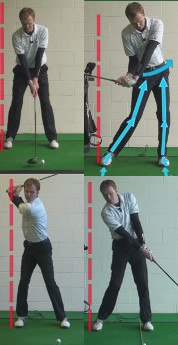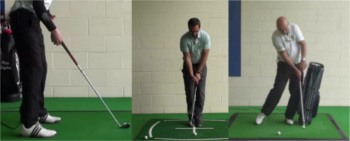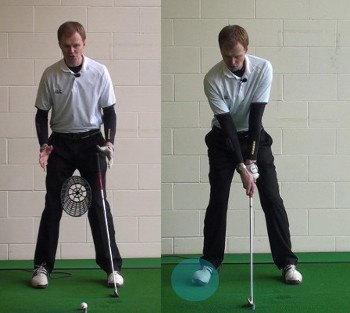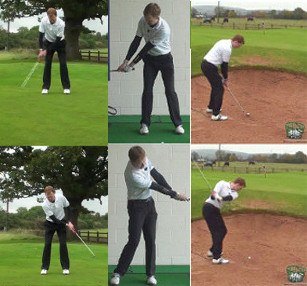In golf the knees are imperative for a solid golf swing. During the takeaway the arms and left shoulder initiate the takeaway while the lower body remains still. Once the club reaches waist high, the wrists hinge, hips begin to rotate and the left shoulder turns under the chin while the hands continue up to the top of the backswing. A little known secret of the golf swing includes maintaining the original knee bend, which in turn helps deliver more power at impact. In fact, the right and left knee flex maintain the original knee flex during the backswing.

The golf swing is a rotational movement where the arms swing the club around the spine. Lateral movements generally involve some form of swaying throughout the swing. However, in golf the knee bend is directly responsible for many vertical movements. Specifically, the right knee straightens and the left knee dips. When this happens the spine angle moves from the original position to an upward position, and then must return back, similar to the original position at address. There are several compensations occurring that typically result in inconsistent contact. The swing is difficult enough, especially when you factor in additional and unnecessary movements that occur in the second you swing the club. With additional and extra steps it should be simple to understand how difficult it is to make solid and consistent contact. Now, just imagine if you maintain the original spine angle. One simple move such as straightening the right knee during the backswing causes an entire chain reaction of extra movements that make creating a consistent and repeatable swing almost impossible.
| GOLF FIXES BY PGA PROS |
|---|
| How Much Should Your Knees Bend in Setup, Swing? Golf Swing Tip | Video | Article |
| Correct Golf Knee Flex | Video | Article |
| Correct Golf Stance Knee Bend | Video | Article |
| Correct Knee Bend For Golf Posture | Video | Article |
| Correct Knee Bend In The Golf Set Up | Video | Article |
| Knee Bend In The Golf Swing Helps Correct A Reverse Pivot | Video | Article |
| LESSONS |
|---|
| Allow a small front knee flex to aid full turn | Video | Article |
| Golf Putting Thoughts – 3 Frozen Knees | Video | Article |
| Try Arnie’s Locked-Knees Method For Stable Putting | Video | Article |
| Golf Pro Sam Snead: Knee Separation on Downswing | Video | Article |
| Golf Swing Golf Tips – All Time Top Tips – Holding The Right Knee Steady | Video | Article |
| Justin Rose: Right Knee Stays Flexed for Balance, Power | Video | Article |
| Senior Golfer 6 – Allow a small front knee flex to aid full turn, Golf | Video | Article |
| The Effect of Knee Separation on the Rest of Your Swing | Video | Article |
| Hold Onto The Right Knee Position To Stop Golf Backswing Sway | Video | Article |
| Right Knee Control Lesson by PGA Pro Tom Stickney | Video | Article |
| What You Can Learn from Sam Sneads Knee Separation on the Downswing | Video | Article |
| PRACTICE DRILLS |
|---|
| What are stable legs golf Drill 2 Basket between knees | Video | Article |
| Snapping The Left Knee – What It Means In The Golf Swing | Video | Article |
| What is more power and why golf drill 3 Snap front knee at impact | Video | Article |
| GOLF QUESTIONS |
|---|
| What Should My Knees Do During My Putting Stroke | Video | Article |
| Golf Knee Flex, How Much Should I Have During My Set Up To The Golf Ball? | Video | Article |
| GOLF EXERCISES |
|---|
| Knee Hugs Golf Strikes | Video | Article |
| Knee To Chest Golf Stretch | Video | Article |
Every part of your body – from the soles of your feet up to the top of your head – has a role to play in the golf swing. Only when you have everything working together in sync will you be able to reach your potential on the links. In this article, we are going to talk specifically about how your knees can help you produce the kinds of shots that will lead to lower scores.
At first, it would be easy to overlook the importance of your knees in the swing, as they don’t seem to have much to do with how the club moves. When reading general golf instruction, you might not see much about the knees at all – other than that they need to be bent at address. But is that all they need to do? Not really, and we will get deeper into this subject in the content below.
All of the instruction in this article is written from the perspective of a right-handed golfer. If you happen to play left-handed, please take a moment to reverse the directions as necessary.
— Three Basic Keys
To get started, we are going to highlight three basic keys that will help you understand what the knees should be doing in the golf swing. If you can hit on these three points, you will be in good shape not only with regard to your knees specifically, but in terms of your lower body as a whole. The lower body plays an extremely important role in the golf swing, and getting your knees on track will help you make the most of what your legs can do.

- Start with some flex. This is an easy point, so we might as well get started here. When building your stance for any given shot, you will want to flex your knees as you settle into an address position. Knee flex is important for several reasons. For one thing, it will make it easier for you to get the club down to the level of the golf ball without having to bend over from the waist. Also, knee flex is going to naturally engage many of the big muscles in your lower body, helping to set the stage for a golf swing that incorporates your entire body and not just the hands and arms. One of the tricky things about flexing your knees at address is that there is no one set amount of knee flex that is going to work for every player. Some golfers like to sink deep down into the stance, using a lot of knee flex while keeping their upper body rather upright. Others prefer to use just a slight knee flex while tilting significantly forward from the hips. Both methods can work, so it will be up to you to experiment on the range until you find a position that is comfortable and leads to good results.
- Right knee holds its position. Another knee-related key during the golf swing is to keep your right knee relatively stable as you swing back and up toward the top. The knee doesn’t need to stay perfectly still all the way to the top – you probably aren’t flexible enough to make that happen – but try to keep it relatively quiet as you go. Specifically, you don’t want the right knee to be swaying or sliding away from the target. If that right knee is moving too much away from the target, you’ll have trouble staying on balance and you may struggle to make good contact as a result. To work on this point, consider practicing your backswing rotation – without a club – while standing in front of a mirror. As you turn your shoulders away from the imaginary target, watch your progress in the mirror and make sure you aren’t letting that knee slide away too much. If you do manage to keep it steady, you should find that your whole body is nicely balanced at the top and you are ready for an athletic and aggressive downswing.
- Stay down through the transition. The last key in our list of three is to remain flexed in your knees all the way through the transition and into the downswing. It’s easy to come out of your stance at the top, standing up with your legs and losing the athletic position you worked to create at address. By maintaining your knee flex, it will be easier to turn hard toward the target, and you should be able to make clean contact, as well. Going up and down with your knees at the top of the swing will change the level of your whole body and getting back down to impact in the right place will become much harder. You want to make your swing as a whole as simple as you can, and that means eliminating unnecessary movements. Instead of straightening your knees at the top, just keep them steady and maintain your flex as you head down toward the ball.
In the spirit of keeping things simple, you can focus on just these three tips alone as you work on improving the way your knees work in the swing. Could you think about other things, and get into more complicated technical tips? Sure – but that would do more harm than good for most people. If you are heading out for a practice session sometime soon, work on these three keys and you should see some nice progress.
— Common Knee Mistakes
It should come as no surprise that some of the points in this section are going to run counter to the points we made in the previous section. After all, those three points above were what you should be trying to do, so the common mistakes you read about below will run against those points in some way. It’ll be helpful for you to read through this section because you can think about your own swing as you read, looking for issues that need to be corrected.

- Never flexing them in the first place. For some golfers, the address position is something that they virtually ignore. Rather than spending some time learning how to stand properly over the ball, some players just walk up and swing away. That’s an approach that is rarely – if ever – going to lead to good results. The address position is an extremely important part of your golf technique. As mentioned in the previous section, the amount of knee flex that is right for your game is something you’ll need to experiment to find, but you’ll want to at least have your knees flexed slightly. If you stand with your legs completely straight, it will be hard to make a full shoulder turn – and it will be nearly impossible to get your legs involved in the swing in any meaningful way. If you have noticed that you tend to stand with your legs rather straight over the ball, get down to work on this point as one of your top golf priorities.
- Letting the right knee go early. We mentioned in the previous section that you don’t want to let the right knee drift too far to the right during the backswing. Letting that right knee drift can ruin your balance and suck the power out of your swing. Unfortunately, many players lose this battle as soon as the club goes in motion. Rather than turning their shoulders to start the swing, some players slide to the right – and it is usually the right knee that leads the way in this move. If that sounds like your takeaway at the moment, don’t be surprised if your swing lacks power and is terribly inconsistent. You would be able to make a dramatic improvement in your game simply by learning how to get the swing started with nothing other than a simple shoulder turn. Turn your shoulders away from the target while keeping your lower body still and you will be setting yourself up for success.
- Setting them too close together. We didn’t talk about this in the first section, but you need to make sure your stance is wide enough to support the aggressive turn you plan to make through the ball. If your stance is too narrow, it will be hard to hold your balance and you’ll struggle to pick up speed through the hitting area. As a good starting point, try setting your feet just wider than shoulder width apart. Most players like to stand a little wider with the longer clubs than the short clubs, but test out various stances on the range to see what works for you.
- Sliding them toward the target in the transition. You should not be sliding in your golf swing, no matter if you are swinging back or swinging down toward the ball. The golf swing as a whole is a rotational action, and any lateral movement that takes place is simply a side effect of your rotation. When you get to the top of the swing, you should be thinking about turning your hips open to the target. Of course, that action is going to cause your knees to move, but it’s not a conscious action to move your knees at this point. You’ll rotate your hips toward the target and your knees will simply go along for the ride. As long as you have maintained knee flex properly through the transition and into the start of the downswing, this move should be pretty easy to execute. As you continue to practice and gain experience, you’ll get more and more comfortable with the timing of how your hips fire toward the target from the top of the swing.
It’s easy to get off track with how your knees work in the swing, so we hope this section has helped you to understand some of the common pitfalls. Don’t be too hard on yourself if you are making one or more of these mistakes currently – this is a hard game, and everyone has areas in which they can improve. Rather than trying to fix everything all at once, pick out one area to improve and work on that point alone until you are happy with your progress. If you continue in that manner moving forward, you’ll be well on your way to lower scores.
— Two Knee Drills
What do you do when you head to the driving range for a practice session? If you simply toss a bunch of balls down in front of you and swing away, you might not be getting everything you could get out of your time and effort. Practicing with a purpose is important, and you can make meaningful progress much more quickly if you have a goal in mind each time you work on your game.
With that in mind, we are going to highlight two knee-related drills that you may want to try during an upcoming practice session. With these drills in the back of your mind, you’ll always have something worthwhile to work on as you spend time on the range.

- Basketball drill. For this first drill, we are going to take a quick turn away from golf and pick up a basketball. That’s right – you’ll need a basketball for this drill, and you don’t even have to be at the driving range to perform the drill correctly. If you don’t have a basketball available around the house to use for this purpose, a soccer ball would work, as well. To perform the drill, pick up the basketball and place it between your knees so that it says in place as you take your golf stance. You aren’t even going to be holding a club, but you should settle into a mock address position as if you were going to hit a shot. Then, with the basketball between your knees, turn your shoulders back and pretend to make a full backswing. As you go up toward the top of this pretend swing, make sure the basketball stays in place. If your right knee drifts too far away from the left, the basketball will fall to the ground and you will know that you have made a mistake. Also, placing the ball between your knees will make sure they don’t get too close together, which is another common issue for some players. After a few pretend backswings with the ball between your knees, set it to the side and make some regular practice swings while you focus on maintaining that same knee positioning.
- Right foot wedge. This second drill is also going to help you keep your right knee in position during the backswing. You can do this drill at home if you have enough room to safely make some practice swings – otherwise, it is a good one to do at the range. Take one of your mid-irons from your bag and pick out a spot to swing. Before making any practice swings, however, take an extra golf ball and place it under the outside of your right foot. You should be standing on the ball with the outside of your foot, so that the inside of your foot is rolled down to the ground. Positioning the ball this way is going to make it something of a ‘wedge’, holding your foot in place and not allowing your right knee to stray too far to the right during the backswing. With the ball in place, go ahead and make a few practice swings to see what it feels like to keep your knee stable. Most likely, this is going to feel a little weird and restrictive at first. And that’s okay. Make a few more practice swings and then remove the ball before hitting some shots down the range. You don’t necessarily have to restrict your knee movement quite as much as in that drill, but the drill should give you a good feeling for how stable knees can help your swing be more consistent.
Gaining a benefit from any kind of golf drill comes down to consistency and repeating the drill from time to time. Work these two into your golf practice routine and you’ll hopefully see improvements in your performance sooner rather than later.
— Knees in the Short Game
To finish up out discussion on the knees in golf, we are going to shift our focus to the short game. It’s always important to talk about the short game in any golf instruction discussion, since it plays such an important role in scoring. It might be fun to blast those long drives down the fairway, but you are never going to reach your potential without a solid short game to carry you through all 18 holes.
With that in mind, we’d like to highlight a few important points that address how your knees should work when chipping and putting.

- Complete silence when putting. While you are making a putting stroke, your knees should be doing absolutely nothing at all. If you can keep them completely still, your lower body will be totally still as well – and that should mean great things for your stroke. A quiet lower body allows you to rock your shoulders back and forth to send the ball on its way. Great putting is all about simplicity and eliminating moving parts. You want to hit the ball as close to the target line as possible over and over again – and keeping your knees perfectly still is a great way to do just that. As you work on your putting, use your kneecaps as a good reference for the quality of your technique. If they aren’t moving as the putter swings, you can be sure you are doing something right.
- Angle the right knee in on chip shots. One handy way you can use your knees to your advantage on chip shots is to angle your right knee in a bit at address when chipping. This adjustment will solidify the position of your right leg and make it less likely that you’ll sway off the ball in the backswing. Letting your right knee sway away from the target is just as big of a problem in the short game as it is in the long game, so try leaning that right knee in a bit at address to stay away from this costly mistake. You don’t want to make this position so dramatic that it becomes uncomfortable or awkward – just enough to make sure your right knee doesn’t go wandering once the stroke starts.
- Plenty of flex in a greenside bunker. One of the big mistakes made by amateur golfers in greenside bunkers is failing to flex the knees sufficiently. You will need more knee flex here than perhaps any other shot in the game. There are a couple of reasons that it’s so important to get into a deep knee flex while playing an explosion shot from the sand. First, you need to get down so low because you are actually trying to swing under the ball. Remember, when blasting out of the sand, you need to swing down deep into the sand to cause the ball to float up and out nicely. You aren’t trying to hit the ball cleanly – you are basically trying to hit it fat so the sand can do the work for you. It will be much easier to get down deep enough in the sand if you flex your knees significantly. Also, it’s often the case that your feet are a little above the ball in the sand, which only furthers the need to get down deep with your knee flex.
We hope this discussion on how your knees can help you improve your golf game will help you make progress in the near future. Remember, nothing happens automatically in golf, so don’t assume you’ll improve your play simply by reading this article. You have to get out there and work on your game if you hope to make any meaningful gains. Thank you for reading and good luck!






